2009 CHEVROLET SILVERADO wheel alignment
[x] Cancel search: wheel alignmentPage 414 of 600
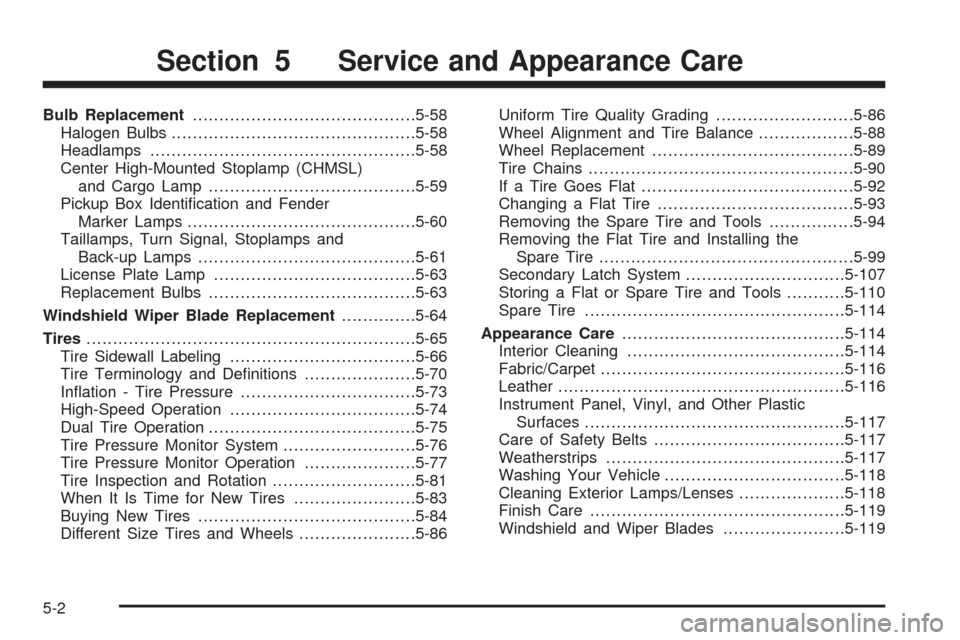
Bulb Replacement..........................................5-58
Halogen Bulbs..............................................5-58
Headlamps..................................................5-58
Center High-Mounted Stoplamp (CHMSL)
and Cargo Lamp.......................................5-59
Pickup Box Identi�cation and Fender
Marker Lamps...........................................5-60
Taillamps, Turn Signal, Stoplamps and
Back-up Lamps.........................................5-61
License Plate Lamp......................................5-63
Replacement Bulbs.......................................5-63
Windshield Wiper Blade Replacement..............5-64
Tires..............................................................5-65
Tire Sidewall Labeling...................................5-66
Tire Terminology and De�nitions.....................5-70
In�ation - Tire Pressure.................................5-73
High-Speed Operation...................................5-74
Dual Tire Operation.......................................5-75
Tire Pressure Monitor System.........................5-76
Tire Pressure Monitor Operation.....................5-77
Tire Inspection and Rotation...........................5-81
When It Is Time for New Tires.......................5-83
Buying New Tires.........................................5-84
Different Size Tires and Wheels......................5-86Uniform Tire Quality Grading..........................5-86
Wheel Alignment and Tire Balance..................5-88
Wheel Replacement......................................5-89
Tire Chains..................................................5-90
If a Tire Goes Flat........................................5-92
Changing a Flat Tire.....................................5-93
Removing the Spare Tire and Tools................5-94
Removing the Flat Tire and Installing the
Spare Tire................................................5-99
Secondary Latch System..............................5-107
Storing a Flat or Spare Tire and Tools...........5-110
Spare Tire.................................................5-114
Appearance Care
..........................................5-114
Interior Cleaning.........................................5-114
Fabric/Carpet..............................................5-116
Leather......................................................5-116
Instrument Panel, Vinyl, and Other Plastic
Surfaces.................................................5-117
Care of Safety Belts....................................5-117
Weatherstrips.............................................5-117
Washing Your Vehicle..................................5-118
Cleaning Exterior Lamps/Lenses....................5-118
Finish Care................................................5-119
Windshield and Wiper Blades.......................5-119
Section 5 Service and Appearance Care
5-2
Page 493 of 600
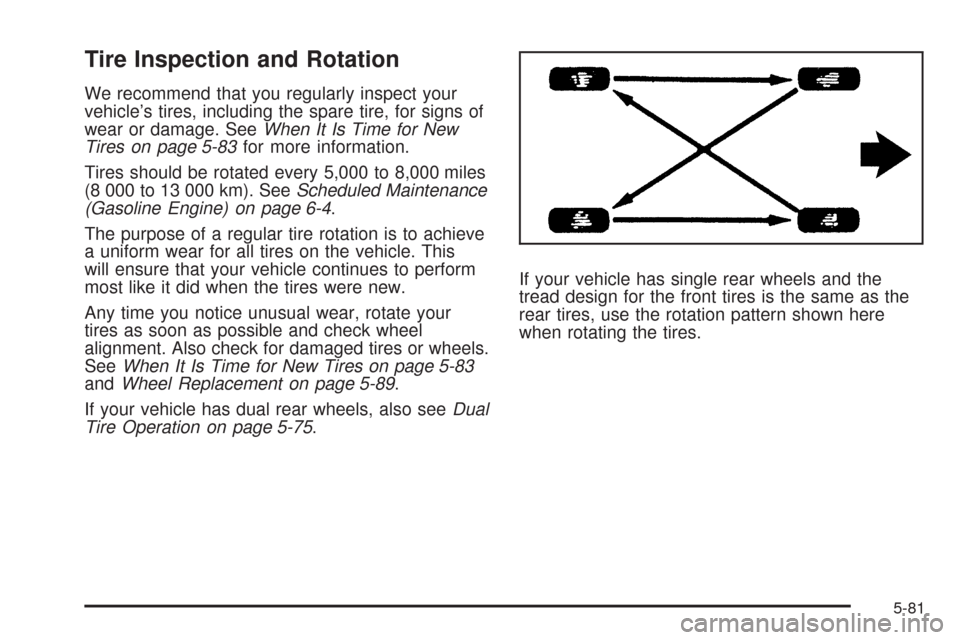
Tire Inspection and Rotation
We recommend that you regularly inspect your
vehicle’s tires, including the spare tire, for signs of
wear or damage. SeeWhen It Is Time for New
Tires on page 5-83for more information.
Tires should be rotated every 5,000 to 8,000 miles
(8 000 to 13 000 km). SeeScheduled Maintenance
(Gasoline Engine) on page 6-4.
The purpose of a regular tire rotation is to achieve
a uniform wear for all tires on the vehicle. This
will ensure that your vehicle continues to perform
most like it did when the tires were new.
Any time you notice unusual wear, rotate your
tires as soon as possible and check wheel
alignment. Also check for damaged tires or wheels.
SeeWhen It Is Time for New Tires on page 5-83
andWheel Replacement on page 5-89.
If your vehicle has dual rear wheels, also seeDual
Tire Operation on page 5-75.If your vehicle has single rear wheels and the
tread design for the front tires is the same as the
rear tires, use the rotation pattern shown here
when rotating the tires.
5-81
Page 500 of 600
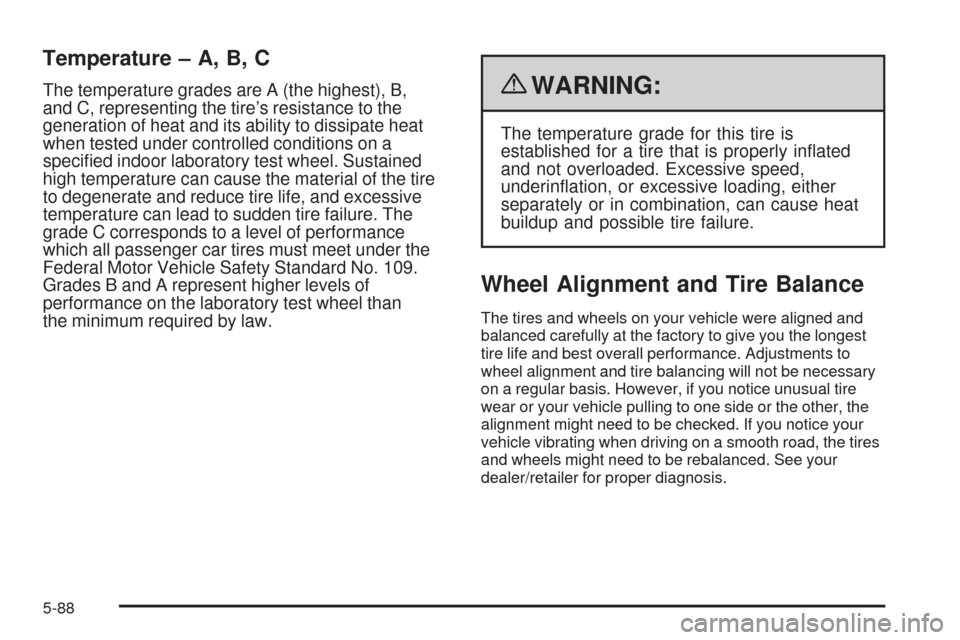
Temperature – A, B, C
The temperature grades are A (the highest), B,
and C, representing the tire’s resistance to the
generation of heat and its ability to dissipate heat
when tested under controlled conditions on a
speci�ed indoor laboratory test wheel. Sustained
high temperature can cause the material of the tire
to degenerate and reduce tire life, and excessive
temperature can lead to sudden tire failure. The
grade C corresponds to a level of performance
which all passenger car tires must meet under the
Federal Motor Vehicle Safety Standard No. 109.
Grades B and A represent higher levels of
performance on the laboratory test wheel than
the minimum required by law.{WARNING:
The temperature grade for this tire is
established for a tire that is properly in�ated
and not overloaded. Excessive speed,
underin�ation, or excessive loading, either
separately or in combination, can cause heat
buildup and possible tire failure.
Wheel Alignment and Tire Balance
The tires and wheels on your vehicle were aligned and
balanced carefully at the factory to give you the longest
tire life and best overall performance. Adjustments to
wheel alignment and tire balancing will not be necessary
on a regular basis. However, if you notice unusual tire
wear or your vehicle pulling to one side or the other, the
alignment might need to be checked. If you notice your
vehicle vibrating when driving on a smooth road, the tires
and wheels might need to be rebalanced. See your
dealer/retailer for proper diagnosis.
5-88
Page 599 of 600
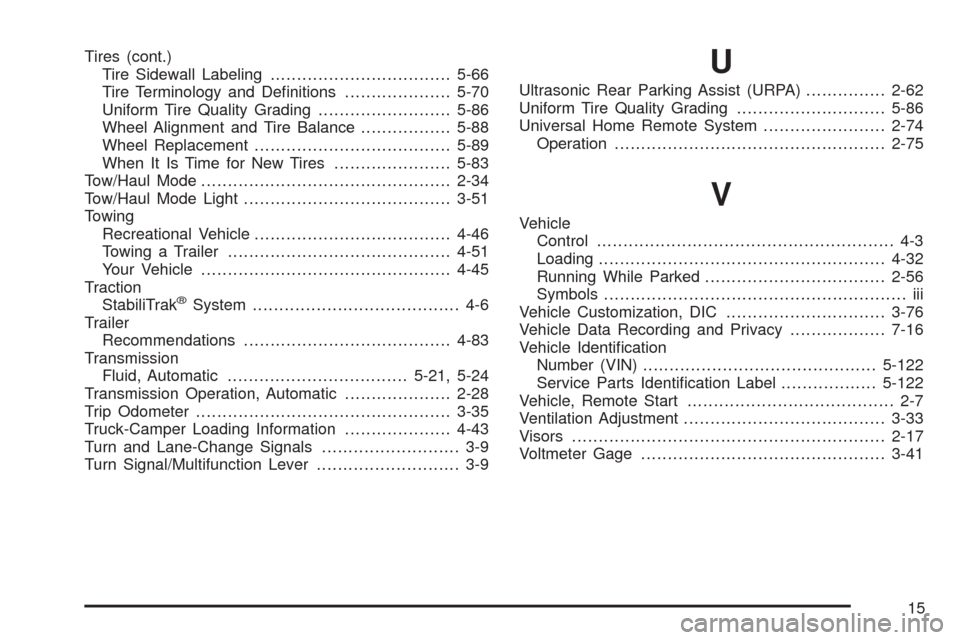
Tires (cont.)
Tire Sidewall Labeling..................................5-66
Tire Terminology and De�nitions....................5-70
Uniform Tire Quality Grading.........................5-86
Wheel Alignment and Tire Balance.................5-88
Wheel Replacement.....................................5-89
When It Is Time for New Tires......................5-83
Tow/Haul Mode ...............................................2-34
Tow/Haul Mode Light.......................................3-51
Towing
Recreational Vehicle.....................................4-46
Towing a Trailer..........................................4-51
Your Vehicle...............................................4-45
Traction
StabiliTrak
®System....................................... 4-6
Trailer
Recommendations.......................................4-83
Transmission
Fluid, Automatic..................................5-21, 5-24
Transmission Operation, Automatic....................2-28
Trip Odometer................................................3-35
Truck-Camper Loading Information....................4-43
Turn and Lane-Change Signals.......................... 3-9
Turn Signal/Multifunction Lever........................... 3-9
U
Ultrasonic Rear Parking Assist (URPA)...............2-62
Uniform Tire Quality Grading............................5-86
Universal Home Remote System.......................2-74
Operation...................................................2-75
V
Vehicle
Control........................................................ 4-3
Loading......................................................4-32
Running While Parked..................................2-56
Symbols......................................................... iii
Vehicle Customization, DIC..............................3-76
Vehicle Data Recording and Privacy..................7-16
Vehicle Identi�cation
Number (VIN)............................................5-122
Service Parts Identi�cation Label..................5-122
Vehicle, Remote Start....................................... 2-7
Ventilation Adjustment......................................3-33
Visors...........................................................2-17
Voltmeter Gage..............................................3-41
15
Page 600 of 600
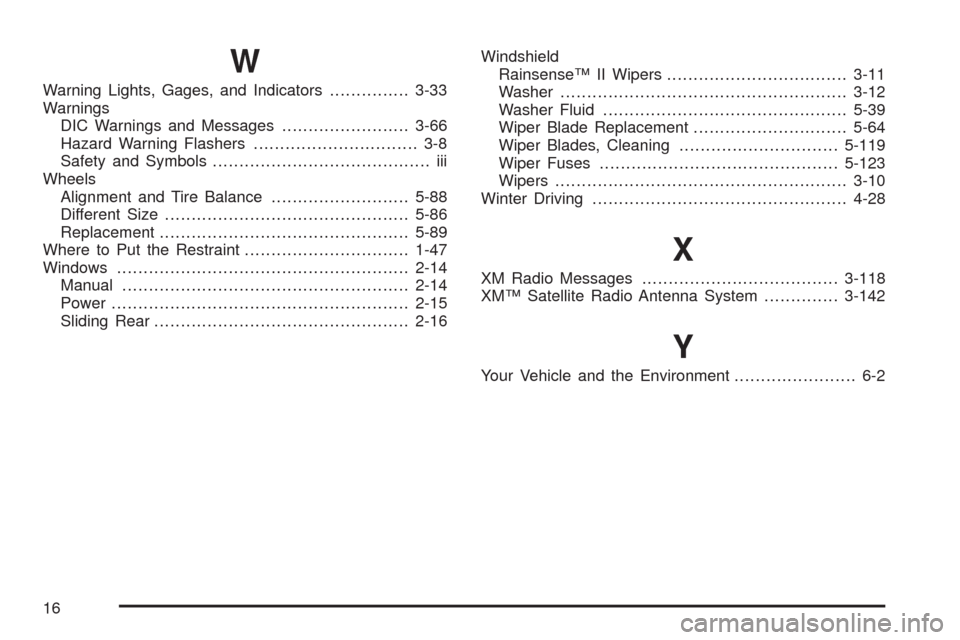
W
Warning Lights, Gages, and Indicators...............3-33
Warnings
DIC Warnings and Messages........................3-66
Hazard Warning Flashers............................... 3-8
Safety and Symbols......................................... iii
Wheels
Alignment and Tire Balance..........................5-88
Different Size..............................................5-86
Replacement...............................................5-89
Where to Put the Restraint...............................1-47
Windows.......................................................2-14
Manual......................................................2-14
Power ........................................................2-15
Sliding Rear................................................2-16Windshield
Rainsense™ II Wipers..................................3-11
Washer......................................................3-12
Washer Fluid..............................................5-39
Wiper Blade Replacement.............................5-64
Wiper Blades, Cleaning..............................5-119
Wiper Fuses.............................................5-123
Wipers.......................................................3-10
Winter Driving................................................4-28
X
XM Radio Messages.....................................3-118
XM™ Satellite Radio Antenna System..............3-142
Y
Your Vehicle and the Environment....................... 6-2
16